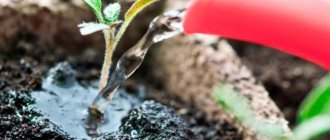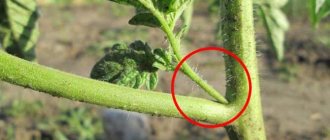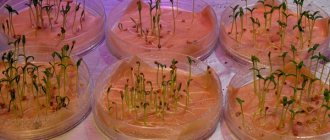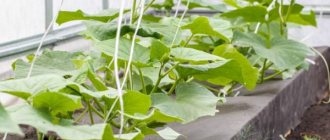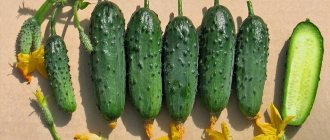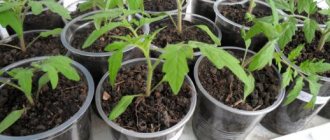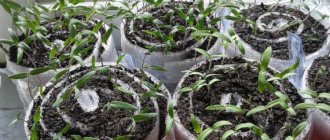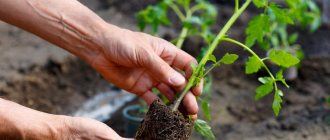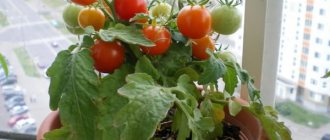General provisions
Reference. A diaper is a small bundle of fabric (usually a paper towel or toilet paper) and plastic film (plastic bag, stationery file, notebook cover, etc.), into which seeds are sown and seedlings are planted.
The germination rate of seeds with this sowing method is quite high. This is explained by the fact that they find themselves in an ideal environment for germination and growth: high humidity, maintained by constantly moistening the paper, and the temperature rising inside the plastic wrap, together create a “greenhouse effect” that has a beneficial effect on the development of the future plant.
What to make diapers and substrate from
For diapers, any thick polyethylene, cut into squares or rectangles, is suitable. You can take ordinary cellophane bags. If they are too thin, fold the bag 2-3 times.
Not suitable for making diapers:
- Food bags. Even after washing, traces of organic matter remain on them, which, when decomposed, can harm the tomatoes. Vegetable bags may contain pathogens. If you use aggressive detergents for washing, this will also not benefit the tomatoes. It is difficult to completely remove them from the surface even by repeated rinsing. In any case, it is much easier to use new bags for diapers.
- Packages that have been in contact with aggressive chemical compounds.
- Leaky cellophane - the substrate spills through it.
- Old fragile film. Even seemingly intact pieces cut out of it can crumble during operation under the influence of moisture. And then all the efforts of the gardener will go to waste.
The substrate can be commercial soil for seedlings or toilet paper. If the owners are accustomed to making soil mixture for sowing tomatoes on their own, they use it.
To plant tomatoes in diapers you may need:
- scissors for cutting film;
- elastic bands;
- when planting a large number of varieties - waterproof markers, toothpicks, skewers;
- containers in which diapers will be stored;
- cellophane to create a greenhouse effect during seed germination.
Description of the essence of the method
How to grow tomatoes this way? The method of germinating seeds in a diaper is quite simple. We plant tomato seeds in paper, which are distributed over a moistened paper strip, which, in turn, is located on a plastic strip of the same size.
A paper-polyethylene tape with seed material is rolled into a “roll” and immersed in a container, at the bottom of which there is always water. The principle of wrapping seeds is similar to the principle of swaddling an infant - hence the consonance of the names.
Basics of proper picking
When picking, you need to follow a few simple rules. This is how you can get healthy plants that will give a rich harvest in the future.
Depth during picking process
The depth of seedlings should be moderate, up to the cotyledons. Having filled the hole with soil, lightly compact the soil with your fingers. But do not overdo it, the soil should allow water and air to pass well.
To prevent the root of the plant from bending, make the hole deeper.
Pinching the roots
It is recommended to pinch the root if the picking is carried out when it is already strong and strong. It is such a root that can survive the picking process and develop a more powerful root system. In addition, it has already reached a significant length and may not fit into the container prepared for transplantation.
If picking is carried out before the formation of true leaves in young seedlings, then it is better not to pinching. This can slow growth and weaken the eggplant.
Advantages and disadvantages
Recently, this method of sowing seeds has become very popular, especially among residents of megacities: the diaper method is ideal for small apartments, since seedlings grown in this way do not occupy a large area, and all containers can be successfully placed on one windowsill.
Another plus: the method will help save money . The gardener will not have to spend money on purchasing a substrate, fungicides for its treatment, or containers; cut polyethylene tapes can be stored for years, and if you purchase low-quality seed, it can be easily replaced without experiencing significant losses both in material terms and in terms of physical effort.
There are also disadvantages: plants in a diaper and their root system develop more slowly than in a container; Also, the seedlings will still have to be transplanted into a larger container.
About the features of diaper seedlings, advantages and disadvantages
If, while preparing for the coming summer season, you hear about seedlings in diapers, then do not think that we are talking about a children's cotton sheet, even though the principle of “wrapping” is similar for both cases. By plant wrap we mean PET film - for example, the one used to cover greenhouses and hotbeds. In some cases, instead of film, a simple transparent bag can be used, the dimensions of which on average are 20x30 centimeters. Such bags, by the way, are not recommended, as they can significantly deteriorate the quality of the grown seedlings.
Growing seedlings in diapers is a good way to save space on the windowsill
Be that as it may, the use of film allows you to avoid cluttering the window sills with numerous plastic cups, pots or seedling boxes.
Note! Due to the fact that it was the residents of Moscow who were the first to appreciate the method described in the article, one of its several options began to be called “Moscow style”. But that’s not what we’re talking about now.
As for the advantages of the method, these include:
- significant space savings when planting seeds;
- convenience of picking seedlings;
- reducing the required volume of nutrient soil mixture;
- the possibility of using it (the method) as a “plan B” in case nothing worked out with the main seedlings;
- protection of seedlings from diseases that are transmitted through the soil (for example, from blackleg);
- ease of checking the germination of seeds (especially last year’s).
Seedlings in diapers will save space on the windowsill
However, there are also disadvantages that should also be kept in mind; in particular, these include the following points:
- seedlings receive less light and therefore develop slowly;
- after the emergence of seedlings, picking may be required (much depends on the specific type of plant);
- Despite the intensive growth of the stems, the roots develop rather weakly.
Note! The use of diapers is applicable for most cold-resistant plants (not only flowers, but also vegetables). In the future, such plants will not require transplanting into separate containers before final rooting. As for heat-loving crops, they will have to be replanted in any case.
As mentioned earlier, there are several ways to “swaddle” seedlings. Some grow plants in film with soil or coconut substrate, while others do without them altogether. Also, only seeds can be packaged in film for the purpose of their subsequent transplantation into individual containers with soil. And so that you can choose the most suitable method for yourself, we will familiarize ourselves with all the existing options.
Seedlings in a diaper
By the way, regardless of the chosen method, you can always resort to a little trick. Take a strip of adhesive tape and write the number/name of the variety on it, then stick it on the diaper. You can also write directly on the film using a waterproof marker (here you need to wait until the writing dries). In this case, you will not only not get confused, but will also be able to observe the germination of different varieties.
Cups with seedlings are numbered
Seed preparation
- Disinfection .
Most infectious diseases of tomatoes are transmitted through soil, containers and seed. Since the method of germinating seeds in a diaper does not require either a large quantity of substrate or a container, the issue of disinfecting the seed material comes to the fore. For these purposes, the seeds can be immersed for 20 minutes in a 1% solution of potassium permanganate (1 gram per 100 ml of water) or for 8 minutes in a 2–3% solution of hydrogen peroxide, heated to +40C. - Treatment . After disinfection, it is recommended to immerse the seeds in a nutrient solution of a growth stimulator to ensure a higher percentage of germination: you can use both purchased preparations (Epin, Zircon, Heteroauxin, etc.) and prepared yourself (aloe juice solution (1:1) or honey water (1 tsp per glass of water).
- Soaking . Experienced gardeners also recommend soaking the seeds for 12 hours in warm water (+25C) before sowing, which must be changed every 4 hours.
- Germination. And for one of the methods, which will be discussed below, you will need already sprouted seeds. For these purposes, you need to prepare a saucer, cloth, gauze or paper towel.
Moisten the fabric, place it flat on a saucer, pour tomato seeds of the same variety onto it and spread over the surface, cover the container with a plastic lid or plastic bag and place in a warm place (+23C - +25C) for 3 - 5 days.Important. All this time, it is necessary to ensure that the fabric is constantly kept wet, otherwise the seeds will simply dry out.
Growing tomato seedlings without soil
If there is not enough space for a large number of seedlings on window sills and balconies, an economical way of growing seedlings of vegetables and flowers in diapers has been invented, since it only requires plastic bags and a little soil. It gained particular popularity in the Moscow region, so it became known as the Moscow method. This is also true in small apartments with narrow window sills.
Advantages of growing seedlings in diapers
Like any other growing method, this has a number of disadvantages and advantages. The positive aspects of the snail method include:
- ease of planting seeds;
- saving space;
- a small amount of soil;
- ease of diving;
- absence of diseases acquired from the soil (black leg);
- keeping the spine intact during picking;
- quick rejection of low-quality material;
- adding soil or placing it in a large diaper without causing injury to the roots of the seedlings;
- ease of transplanting seedlings into the ground.
Disadvantages include:
- insufficient nutrition leads to slow growth;
- insufficient lighting can lead to stretching of seedlings;
- the roots are cramped in a small volume of soil and they develop poorly.
Germinating seeds in a snail
If the gardener did not prepare the soil in advance, in the fall, or forgot to buy it in the store, there is a very simple way to germinate vegetable and flower seeds without soil. For this you will need:
- food bags or film;
- toilet paper or paper towels;
- tomato seeds.
- A regular food bag is folded in half, with the edge facing away from you.
- Place several layers of toilet paper on it, without going beyond the edges of the bag.
- Prepare a nutrient solution with a root former. 2 drops of epin are added to 500 ml of water, or 20 ml (2 incomplete tablespoons) of 3% hydrogen peroxide are diluted in 1 liter of water. Experts believe that the composition of this solution is close to the composition of rainwater during a thunderstorm (the water is saturated with oxygen).
- Draw the solution into a syringe and wet the paper.
- Take the tomato seeds out of the bags and place them on damp paper, keeping a distance of 1 cm from the edge and 1.5-2 cm from each other.
- The paper is moistened with the solution again.
- Roll the bag of seeds into a roll (snail).
- Write the name of the variety on top with a waterproof marker.
- Place a rubber band on top to keep the snail from unfolding.
- Place in a plastic glass. One small glass contains 5 to 10 such diapers (snails), in which from 50 to 80 seedlings will sprout in a few days.
- Add a nutrient solution to a glass to a height of 1-2 cm
- The top is covered with a plastic bag, creating a microgreenhouse inside.
- Place in a warm place for several days (5 to 15 days).
- When loops appear above the surface of the bag, the cover is removed and placed in a warm place that is bright, but not in direct sunlight.
- After all seeds have completely sprouted, the temperature is slightly lowered to avoid stretching the tomato seedlings.
- The seedlings are kept in a rolled-up plant without soil until the first true leaves appear, no more than 2-3 weeks, otherwise the seedlings may die without nutrition.
- If it is not possible to pick up the seedlings in time, unroll the snail, pour a little earth on top and carefully twist it without pressing. The plants can be kept in this state for another 7-10 days.
- Seedlings ready for diving have a long root; if it is rotten or poorly developed, the sprout is discarded.
Using already germinated seed
How to plant tomatoes using germinated seeds:
Prepare everything you need: plastic film, rubber band, substrate (any composition suitable for growing tomatoes), sprouted seeds, container, scissors, spray bottle.
- Rectangles are cut out of the film, the size of which is close to the size of a school notebook.
- Place 1 tbsp in the upper left corner of the prepared rectangle. moistened substrate.
- A germinated seed is placed on top of the substrate so that its cotyledon leaves are above the film.
- For the sprout – 1 more tbsp. substrate, which is also moistened from a spray bottle.
- The bottom edge of the film must be folded and the entire rectangle rolled into a roll. The twist should be free to ensure unhindered access of oxygen to the roots.
- The resulting package is secured with an elastic band and placed in a container. All packages in the container are located close to each other.
- The top of the container can be covered with a transparent plastic film, in which holes are made for air circulation.
- The container with the sprouts is placed in a well-lit and warm place.
Advantages of growing tomato seedlings in “diapers”
- Significantly saves space for growing tomatoes;
- Does not require large amounts of soil and fertilizers;
- Allows you to get good seedlings;
- Seedlings do not suffer from diseases that are infected from the soil, for example, blackleg;
- When transplanting, the roots are not damaged, and the plant takes root immediately, which saves 1-2 weeks of time;
- Cut film can last for several years.
Note!
Ideal for germinating old and questionable seeds, as it does not require large expenses. Therefore, even if the seeds do not germinate, it will not cause any damage;
Growing tomatoes “Moscow style”
- It is necessary to prepare plastic film, toilet paper, seeds, scissors, rubber bands, small containers (disposable plastic cups), and a spray bottle.
- Polyethylene is cut into strips 10 cm wide; their length, like the length of strips of toilet paper, should be about 50 cm, but it all depends on the number of seeds.
- You need to place prepared toilet paper on a strip of polyethylene, which is moistened from a spray bottle.
- The seeds are laid out on the surface in increments of 3–5 cm, 1–1.5 cm from the edge.
- The paper-polyethylene tape is covered with another strip of paper, which also needs to be moistened, and plastic film.
- The tape is wrapped in a roll and secured with an elastic band.
- The package is placed in a container, at the bottom of which water (1.5 - 2 cm) is poured.
For your information. A growth stimulator can be added to the liquid. - The container is covered with a bag with ventilation holes made in it and placed in a warm and bright place.
Growing methods
The popularity of growing tomatoes in a diaper has led to gardeners developing several ways to plant them. Today, every vegetable grower has the opportunity to choose the most suitable option for him, having familiarized himself with all of them in order.
If you use several methods at once, to determine which one is better, apply the appropriate markings to the film material after sowing the seeds.
Using germinated seeds
This method involves growing tomatoes from already prepared, germinated planting material. The process of emergence of seedlings will be as short as possible, and sowing will be fast.
Sowing stages:
- Initially, tomato seeds are germinated in a convenient way. Some people at this stage use growth stimulants and, if necessary, disinfectants;
- the film material must be cut into rectangles the size of a notebook sheet;
- pour a small amount of substrate (1 tablespoon) onto the upper edge of the film, lightly moisten it with warm water using a spray bottle;
- place the sprouted tomato seed on the soil so that the future cotyledon leaves are directed upward;
- pour another spoonful of soil onto the seed and gently spray it with water;
- the lower part of the polyethylene sheet is folded and wrapped in a circle to form a kind of roll - a thin elastic band will help prevent it from unwinding, with which the bundle is securely, but not tightly, fixed;
- tomatoes in diapers, planted in this way, are placed in containers or boxes. If desired, the container can be covered with polyethylene with ventilation holes. If necessary, you need to indicate the variety of tomatoes or the method of germination with a marker. Make appropriate notes on the box or individual diapers.
():
This method involves a large number of manipulations with the substrate and seeds and is costly in terms of wasted time. In production conditions, when growing a large volume of seedlings, completely different techniques are used, which, on the one hand, reduce the sowing time, and on the other hand, create the most comfortable conditions for the seedlings. And this method is cassette growing of seedlings.
Moscow style (without substrate)
Planting by this method does not imply preliminary germination of the seed and is one of the ways to save space. Thus, hundreds of seedlings can be grown on one windowsill.
Planting stages:
- plastic film is cut into long strips 8-10 cm wide;
- paper of the same length is laid on the leveled surface of polyethylene;
- the surface is sprayed from a spray bottle with warm water with the addition of growth stimulants;
- Having retreated 1-1.5 cm from the expected top, using tweezers, carefully lay out the seeds one at a time with a distance of 2-3 cm between them along the entire length of the strip;
- Place the next layer of paper on top of the seeds and moisten it again;
- a second strip of polyethylene is placed on it;
- Carefully roll the film and paper into a roll and secure with an elastic band. There is no need to seal the snail tightly, otherwise you will block the free access of air to the seeds;
- such an amount of water is poured into a suitable container (a half-cut plastic bottle, jar) so that the roll is immersed in it by 1-2 cm. Moisture, rising along the paper, will nourish the seed. It is recommended to enrich the water with substances that stimulate growth;
- the resulting seedlings are covered with a film with holes that allow air to circulate freely inside the mini-greenhouse, and placed in a warm, well-lit place (on a windowsill). The entire period before emergence, it is necessary to maintain the initial water level in the container.
Shoots need picking
Sprouts after one true leaf appears on them with this method of cultivation require picking. To do this, carefully unwind the roll, remove the top part of the film and separate the seedlings along with the paper, trying not to damage the fragile root system of the tomatoes.
Seedlings are planted one at a time in prepared pots or cups, and the soil under them is slightly moistened with warm water.
():
Picking seedlings at an early stage of development requires great care and caution from the vegetable grower, because plants at this stage are still poorly prepared for transplantation.
Snails with soil mixture
This method is similar to the previous one, but this type of cultivation uses a substrate. You can prepare it yourself or use a store-bought one.
Technology:
- Long strips 10-15 cm wide are cut out of polyethylene;
- A layer of fertile soil is laid out on them and lightly moistened with a spray bottle. It is recommended to add growth stimulants to the water;
- seeds (preferably sprouted) or young sprouts of tomatoes, which were formed by growing them in Moscow, are carefully laid out horizontally on the surface of the soil mixture, maintaining a distance of 4-5 cm between them;
- they are sprinkled with a small amount of soil, sprayed with water, and covered with a second strip of polyethylene;
- The seedlings are rolled into a fairly dense roll, secured with an elastic band and placed in a suitable tray, followed by placing it in a well-lit place.
The resulting snail with seedlings will take up more space than with the previous growing method, due to the presence of a layer of soil. The seedlings can remain in this state until they are transplanted to a permanent location.
Planting with substrate
Procedure:
You will need polyethylene strips (10 by 50 cm), tomato substrate, seeds, rubber bands, containers, spray bottle, scissors.
- Place a layer of soil on the film strip and moisten it.
- Stepping back 1.5 cm from the edge, spread the seeds, keeping a distance of 3 - 5 cm.
- On top is a layer of moistened substrate, and then - plastic tape.
- All this must be rolled up, secured with an elastic band and placed in a container.
- Place the container in a warm and well-lit place.
How to grow seedlings in a snail
Although gardeners who practice growing vegetable seedlings in snails claim that it is incredibly simple, it is better to prepare a workplace in advance and analyze the technology in detail.
How to prepare seeds for germination
Regardless of whether you decide to try a new method or remain faithful to the good old boxes and pots, it is better to prepare the seeds for germination. A simple set of measures will allow you to reject low-quality “candidates for sowing”, disinfect and harden the rest. Remember that seeds that have been pre-soaked, fertilized and disinfected produce more vigorous shoots that are not prone to stretching and disease.
- Preparing for sowing, or How to increase seed germination
6 ways to pre-sow seeds and their impact on the future harvest.
How and from what to make a snail for seedlings
In order to make a snail for seedlings, you will need:
- a free table covered with oilcloth or newspapers;
- soft backing for laminate in rolls of one and a half meters (roll width 10 cm);
- transparent containers with low sides;
- plastic bags;
- rubber bands for money;
- tweezers;
- water bottle;
- priming;
- prepared seeds.
It’s better to prepare your workspace and everything you need right away, so you don’t have to get up looking for what’s missing and be distracted from the process. If everything is done correctly and according to the instructions, then it will take only a quarter of an hour to create one snail.
- Partially unroll the backing strip and push one edge toward you.
- Pour the soil over the entire width of the tape, pressing it down with your hand so that the layer is no thicker than 1 cm.
- After the tape has disappeared under the soil by 15-20 cm, take the seeds and begin to lay them out at a distance of 1-2 cm from one of the edges (mark this edge with a marker). Leave a few centimeters between the seeds and lightly press each grain into the soil with your finger.
- Roll the tape with soil tightly into a roll up to the point where the soil ends.
- Holding the roll with your hand, add some more soil and repeat until the tape comes to an end.
- Pull the finished package tightly with an elastic band so that the soil does not spill out. Insert a seed bag under the rubber band so you always know what type of seeds are inside.
- Water the snail generously and place a bag over it to create a greenhouse effect.
- Place the finished snails in the container so that the edge closest to which the seeds are located is on top.
- When shoots appear, remove the bag so that the seedlings do not stretch.
How to store snails with seedlings
Seedlings in snails, like any other, need light and watering. It is better to store containers on window sills - they take up little space, and one window can accommodate the entire seasonal volume. Do not forget about regular watering, because each seed has a thin layer of soil, and the snail dries out quickly.
Picking
One of the important stages of growing seedlings is the picking stage. It can be done by analogy with method No. 1: carefully unwind the diaper to the first sprout, separate it from the substrate with a spatula or fork and place it on a plastic bag in the ground; Having covered it with another handful of soil, the young plant is wrapped in a “cup”, the bottom of which is the folded edge of the bag.
Diving can also be done directly into a container with a moistened substrate : the roll is unrolled, the sprout is removed along with toilet paper and carefully planted in a small depression on the surface of the soil. The plant can be buried down to the first cotyledon leaves, the distance between them is up to 8 cm. After planting, water.
Below you can watch a video about how to pick tomato seedlings into a diaper:
The essence of the method
The main goal of planting tomatoes in diapers is to grow the maximum number of seedlings in a minimum area. The method has many options: with or without picking, on a substrate or toilet paper.
You can put in diapers:
- seeds;
- newly hatched sprouts;
- seedlings ready for picking.
If tomatoes are grown in diapers not for the sake of experiment, but due to a catastrophic lack of space, they can spend the entire time in film envelopes before being transplanted into the garden. Hundreds of young tomatoes will fit on one windowsill.
The essence of growing seedlings in diapers is that the seedlings are not placed in common or individual containers, but are wrapped in polyethylene envelopes. They are swaddled like a baby, secured with an elastic band, or simply placed tightly together so that the bundle cannot open. As the tomato develops, the diapers are unrolled, soil is added, and rolled up again.
It is not recommended to plant all seedlings in a new way for the first time. He may not like it, or something will go wrong. As a result, the gardener will be left without his own planting material. First you need to try on a small number of seeds, take into account all the mistakes, and adjust the method to your own conditions.
Care
The system for caring for seedlings in diapers includes the following elements:
- Systematic (once a day) removal of condensation from the bag covering the diaper container.
- Regular watering (but not excessive).
- Fertilize twice a week with fertilizers based on humic acids (the concentration for immature shoots should be 2 times less than indicated in the instructions).
- Additional illumination with a phytolamp in case of lack of sunlight.
Care, picking and planting seedlings from the diaper into the ground
Proper care of seedlings in diapers consists of:
- timely removal of condensate;
- additional illumination with a lamp when there is a lack of sunlight;
- lack of frequent watering;
- frequent, 1-2 times a week, fertilizing with humic acids. The saturation of the solution should be twice as weak as usual.
It’s quite easy to pick up seedlings from diapers. To do this, you need to take a roll of the plant and see where the roots of the sprout are located. Then step back 2-3 cm from this level and pinch the roots. Finally, you need to remove the top layer of the film, and plant the sprout along with the paper, which will subsequently decompose in the ground, in a separate container.
Picking seedlings into the ground
If possible, plant seedlings grown in diapers in a greenhouse. If you root it immediately in open beds, provide protection from frost. For example, you can make a trench around the perimeter of the bed (as deep as a shovel) and pour fluff or feathers from old pillows that have become unusable into it. Hay or sawdust is also used as ditch filler. The top of the seedlings is covered with film or plastic bottles.
The method of growing in diapers will be of particular interest to summer residents who do not like to tinker with seedlings for a long time, but want to get good results. All methods using film help save space, effort and time. Thanks to the step-by-step algorithm and detailed video instructions, it is almost impossible to make a mistake with the technology. This is exactly the case when with minimal effort you get an excellent result.
How to place it in the ground?
The best option is to plant seedlings from diapers directly into open ground. This can be done without problems if there is a greenhouse on your personal plot. If it is absent, rather weak seedlings will need to be “insulated” in the open ground: sawdust (straw, feathers) should be poured onto the bottom of the planting furrow, and a little soil should be placed on top, into which the young tomatoes will be planted; At night or when there is a threat of return frosts, it is better to cover the seedlings with film or plastic bottles.
Despite the fact that seedlings grown using the diaper method are not as strong as those from a container with soil, with careful care they can please the summer resident with a good harvest. And this with a minimum of money and time! Don't be afraid to experiment and everything will work out.
If you find an error, please select a piece of text and press Ctrl+Enter.
Picking tomatoes in a “diaper”
Picking tomatoes planted in this way is easy and painless for seedlings. To implement it you need:
- Remove the package from the glass;
- Pinch the roots a couple of cm;
- Unfold the diaper;
- Get the sprouts;
- Plant in a permanent place or if it is too early to plant in the ground, then in a separate cup. The paper will gradually dissolve in the soil, so you don’t have to tear it off.
At the same time, the roots are kept intact and do not require time to take root. This saves 1-2 weeks.
Many gardeners and gardeners have tried this method. Most respond positively, noting the advantages: saving space and land. And also how quickly the resulting seedlings take root in a permanent place, both in open ground and indoors.
Note!
Some note that this method takes a lot of time, and the seedlings turn out frail. Therefore, they prefer the conventional method of growing seedlings.
